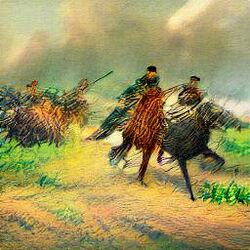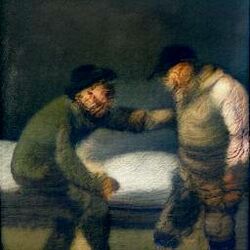Lanzerwaldian-Whaler War
| Lanzerwaldian-Whaler War | |||||
|---|---|---|---|---|---|
|
|||||
| Belligerents | |||||
| Commanders and leaders | |||||
|
|
||||
| Units involved | |||||
|
|||||
The Lanzerwaldian-Whaler War was a conflict that was fought out between the Republic of the United Cities in the Lanzerwald and the Western Natopian Empire and primarily the latter's demesne, the Principality of Whales. The war broke out after Lanzerwald expanded its territory to include the entire region north of Whales, essentially preventing Whales' access to the Cibolan interior.
Factors leading up to the war
Leading up to the war, the republic had met with [ric-character] to determine whether Whales would respond favourably to the expansion. [Ric-character] was not an official representative of Whales but an influential figure in the principality's society nonetheless and only encouraged the republic to claim more than it initially intended.
During the Second Ludwiggian-Monovian War the Liberation Army of Zandarijn, a precursor to the Lanzerwald Republic had attacked and conquered Nieuw Rotterdam
Initial Skirmishes
The first exchange of fire between Whalers and the forces of the RSL occurred on 10.XII.1709 AN when riders of the 1st (Iedźak°'ehe Łaqehe) Cossack Cavalry Regiment, heading northwards from Chur on razzia into the Green, encountered a contingent of dragoon horsemen guarding a party of surveyors who were engaged in the installation of a border-marker. Considering the activities of these strangers to be infringing on the frontiers of Whales, the Cossack commander, Abner Goltz, ordered nine squadrons to dismount and form a skirmish line, whilst he led the remainder, one-hundred and twenty riders in total, towards the perceived intruders. Startled to discover that these men hailed not from Steerswick but rather from the Lanzerwald, Goltz remonstrated with their apparent leader, demanding to know by what right they had presumed to come so far west setting markers. Harsh words were subsequently exchanged and weapons soon drawn. It is not known who fired the first shot, but soon the firing was generalised and the two parties dissolved into a tangled mess of clashing sabres. With battle joined, the Cossack skirmish-line moved forward to engage the intruders. Soon the heathland was strewn with corpses and the Lanzers driven off, leaving the Cossacks in charge of the border-post. A couple of wounded Lanzers were consequently taken captive.
Brought back to Chur and put to the torture, these prisoners had a remarkable tale to tell. Numerous survey parties had ridden westwards, guided and encouraged by the agents and representatives of a coterie of lords in Whales. Their course had been that which was to take them all the way along the northern border of Whales to the furthest point westward, the narrowest point between Whales and the frontier of Steerswick. The testimony was duly recorded and sent by courier to Walstadt whilst the captives were transferred to the ESB's hospital ward where they were kept under guard. The transcripts were received within four days by the Chief Notary to the Court of Cassation & the Court of Admiralty, and in response writs of summons were urgently sent out to the native lords of Whales.
The dragoons and surveyors that had been able to escape the blood spill reported to Major Ferdinand Streichholz, a veteran of the Ludwiggian-Monovian wars. Based on what he heard, and the perceived invitation by Whales to colonise the lands, he assumed that the Principality of Whales, and perhaps the Natopian Empire as a whole, had lured them into an ambush. Compiling his findings in encrypted letters which he sent to the Steden-Generaal, his superior, General Donatien de Lancôme of the Dragonderkorps, General Diederik van Zandt of the 2de Krijgskorps and General Gerhardt Streuß of the 1ste Krijgskorps. The couriers were sent to deliver these message on horseback, and galloped away into the night. After receiving these letters, the generals were summoned by the Steden-Generaal to discuss the strategy and goals of the war. These discussions were held on 19.XII.1709.
Expecting not only an attack by Whales in the south, but also from Zaddi's Bay in the north, Gerhardt Streuß had been given the task to meet the Western Natopian army that was expected to arrive at any moment. As the 1ste Krijgskorps reached the Natopain-Lanzerwaldian border in the north, no signs had been spotted that pointed at a Natopian invasion. Still, Streuß had orders to destroy the Natopian army and he did not wish to let his superiors down.
Before the war started, the United Cities had been close to acquiring new fighter planes from Sanama, but that deal had been put on pause after hostilities had started as treaty obligations prevented Sanama from helping Natopia's enemies. In anticipation of the purchase of these planes, the Luchtkrijgkorps had started re-developing the domestically produced J-1 Lärm into a primitive cruise-missile by fitting it with a rudimentary auto-pilot based on a gyrocompass. The system still relied on a pilot to be present in the aircraft from landing to about 10 minutes before the plane reached its destination, where it would explode. Despite the obvious shortcomings, Gerhardt Streuß anticipated that deploying this system en masse would be his best bet to destroy the fortifications of Zaddi's Bay.
On 2.XIII.1709 Gerhardt Streuß had assembled a total of 120 J-1 Lärm based semi-automatic flying cruise missiles, south of Zaddi's Bay, and also placed his other troops in strategic positions to destroy our route the XXX/4/2 Brigade that was stationed in Zaddi's Bay. The planes were launched by 12 winches and the pilots flew them in the direction of the Natopian military base. As soon as the pilots were able to see the military base, they were instructed to set the mechanical auto-pilot, setting the fuses on the warhead and to escape from the plane with he help of a parachute. For a majority of the planes, the system worked reasonably well and those planes flew into the Natopian base where they wreaked havoc, or they crashed in the vicinity of it. In roughly a quarter of the planes, the auto-pilot caused the plane to crash instantly, or the pilot was unable to escape from the plane before it crashed into the Natopian base. None of the failed planes could be recovered for examination as the fuses worked in all cases and all the planes were destroyed.
Zaddi's Bay
As might be inferred from the launch pattern, the first of ten waves of twelve aerial contraptions bound for Natopian territory on the morning of 2.XIII.1709 AN crossed over into Natopian territory from the south and was detected by the outpost of the XXX/4/2/1 Light Infantry Regiment nearest to the intruder flightpath, with further sightings noted by a patrol of the XXX/4/2/2 Dragoon Regiment returning to the battlegroup marshalling area of it's demi-regiment. Both instances of visual observation of the intruder aircraft were radioed back to the XXX/4/2/0 Command & Control Regiment at Zaddi's Bay.
Apprised of the incursion, the commandant of the Zaddi's Bay Defense Zone ordered the cantonments, airfield, and spaceport into a full lockdown with the XXX/4/2/3 Area Defence Regiment ordered to man the nine defensive strongpoints of the perimeter and the eighteen pintle-mounted heavy machine-guns protecting the airfield. NDF aerospace personnel meanwhile hurried to move the solitary light transport shuttle present at the spaceport into the nearest hanger. As sirens blared all other non-essential personnel were ordered to head for the nearest shelter.
At the elapse of two hours the first intruder aircraft were spotted after reports of parachutes descending from the south-west were observed. These were swiftly engaged with anti-aircraft fire from the eighteen Polybolos 12.7 mm heavy machine-guns positioned to protect the approaches to the airfield. Five of the contraptions, listed in the NDF identification database as a primitive Cibolan cadet training aircraft, were soon spiralling towards the Micrasian soil in flames. Those watching the spectacle from the perimeter defences could only watch in horror as the remaining seven aircraft plunged downwards onto the cantonment area. A solitary aircraft had fallen on the taxiway of the airfield, another had struck the coolant storage area of the spaceport, and yet another again had struck the NDF barracks complex. Each impact had resulted in a cacophonous explosion that seemed out of all proportion to the size of the flimsy aircraft that had delivered the blows. Worse yet, the bunkers which housed the command and control infrastructure for the cantonment and the entire defence zone had been bracketed by a series of three sequential explosions. A troop of forty men from the Security Cohort loaded up into Snatch Land Rovers and headed beyond the perimeter to hunt down the reported parachutists. As they did so, all available personnel not presently assigned to the defence of the cantonment were hurried out of their shelters and formed into firefighting details and dispatched off in the directions of greatest need. The fire in the coolant storage area of the spaceport was a priority concern. The command and control bunker had seemingly survived its ordeal, although its myriad assortment of communications antennas had been comprehensively wrecked. Nothing important appeared to be burning at the airfield, and the shallow crater could doubtless be filled in. Instead the highest priority was to control the fire that had broken out after one of the jerry-rigged drones had detonated in the courtyard of the cantonment hospital, collapsing the southern wall.
No-sooner had these ad hoc response teams formed up and arrived at the scenes of the worst devastation than the air-raid sirens had begun to wail anew. With communications interrupted there had been no warning of the further nine waves of flying bombs that had now heaved into view on their final approach towards the cantonments, parachutes already descending in their wake.

